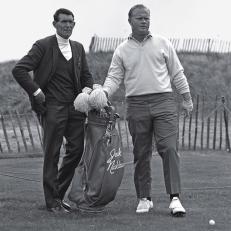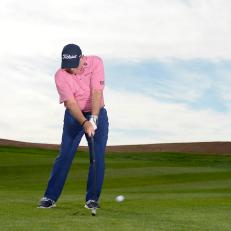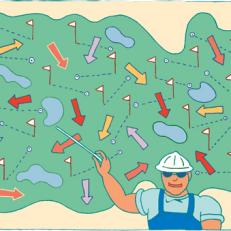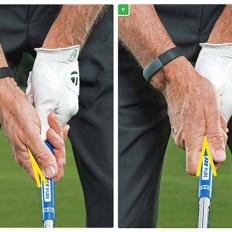13 Quick Swing Fixes
When Ben Hogan called golf "a game of misses," he probably wasn't talking popped-up drives, worm burners and shanks (a miss for ol' Ben was likely a groove low on the face). But hey, this is the hand most golfers have been dealt, so instead of playing the blame game every time you hit a bad shot -- glaring at that chirping bird, gesturing indignantly at the ground where the ball was lying, examining the club for some strange malfunction -- get real and find out why you hit the shots you hit.
THE SLICE
How to save faceAhhh, the dreaded slice. It starts out OK but takes a right turn in midair and flies headlong into whatever trouble is lurking down the right side. It happens when the clubface at impact is open to the path of the swing. Golf Digest Teaching Professional Rick Smith says you can use your wristwatch to eliminate a slice. If you're wearing a watch on your left wrist (right wrist for left-handers), you have the key to squaring the clubface. "On the downswing, as your club is approaching the ball, focus on rolling your watch face over so it's pointing to the ground in the follow-through," Smith says. "This'll get you to rotate your forearms and close the face enough before impact to beat that banana ball."-- Ron Kaspriske
THE HOOK
Saving face, Part 2Minnesota fats probably never hit a pool ball left of his target. Know why? He knew that to keep the ball from going left, he had to avoid hitting the right side of the ball. Same is true of a golf ball, says San Francisco-based teacher Josh Zander. To hook a ball from right to left, the clubface has to make contact with the outside half of the ball, the half that's farther away from you (which means the clubface is closed at impact). To prevent that, Zander says you should focus on making contact with the inside part of the ball. "Pick a dimple on the back of the ball, but on the half closest to you," Zander says. "Try to hit that dimple with the center of the clubface. Do it right, and they'll be leaving money on the table for you."-- Ron Kaspriske
THE PUSH
It's your other rightLaunching one straight right often feels powerful because you're hitting with a square clubface, but you're still heading to the right trees to search for it. The issue with a push -- a shot that starts right and stays on that line -- is that the club comes into impact too far from the inside; you're swinging too in to out. Top-ranked teacher Butch Harmon says the push happens when the lower body is overactive at the start of the downswing, spinning open and causing the club to get stuck behind the body. The best way to fix it, Harmon says, is to take a dramatically closed stance. "That immobilizes the lower body and makes it easier for the arms to catch up and swing past the chest."-- Peter Morrice
THE PULL
A path left traveledHey, tough guy, stop trying to smash the ball with your upper body. The pull -- a shot that starts left and stays on that line -- usually comes from hitting too hard with the right arm and shoulder. The shoulder lurches out toward the ball at the start of the downswing, which throws the club to the outside, causing an out-to-in swing at impact. The clubface is square to the path, so the ball flies straight left. Butch Harmon says the key to avoiding a pull is keeping the right shoulder back. "Make some right-arm-only swings with your left hand on your right shoulder, holding it back as you swing down," Harmon says. "The club will drop to the inside, and you'll lose the out to in."-- Peter Morrice
THE TOPPED SHOT
Dismiss this missTopping your tee shots? No worries -- even the best golfers in the world roll one on occasion. Matt Killen, a Golf Digest Best Young Teacher, says a loss of posture -- typically with your shoulders and hips spinning out on the downswing -- produces the top, where you make contact with the upper half of the ball. Killen says there are two thoughts that will help eliminate the top:• Keep your left hip over your left foot as you go through (above). That prevents the spinout;• Picture your chest pointing to the ball at impact. That prevents any loss of body posture.When all else fails, try this classic: head still.-- * Stephen Hennessey*
THE TOE HIT
Center your strikeShots off the toe of a driver feel bad enough, but toe hits with the irons are among the least forgiving in golf, diving left and losing much of their carry distance. Scott Davenport, the golf professional at the Quail Hollow Club in Charlotte, says one trick will cure toe hits right away. "When you practice, place a second ball just inside the heel of your iron," he says. "Make an easy swing with one goal in mind: Avoid hitting the second ball." Davenport says toe shots usually result from an out-to-in swing. "This drill teaches you to swing more from the inside," he says. "It also tackles another cause of toe shots: releasing the club too early with your hands."-- Guy Yocom
THE HEEL HIT
Centering it, Part 2Misses off the heel of the club come in two varieties: (1) the off-center hit that scuttles low and to the right, the vibration from poor contact stinging your hands, and (2) the shank, which ... well, let's just say the ball goes even farther right. "Heel misses usually result from an exaggerated in-to-out swing path through impact," says teacher Scott Davenport. "If you practice making your divots point a hair left of the target -- and keep your left wrist flat through impact -- there's a good chance your heel hits will disappear." As a bonus, you can stop thinking the shank is a millimeter away.-- Guy Yocom
THE FAT SHOT
You a heavy hitter?Just like people, fat shots range from slightly heavy to complete chunks. No matter the severity, the cause is the same: The clubhead hits the ground before the ball. "The solution is to move the low point of your swing farther forward," says Kevin Hinton, director of instruction at Piping Rock Club in Locust Valley, N.Y. You want to feel that the shaft and your body weight are more forward at impact than they were at address. As a practice drill, Hinton says place a scorecard three inches behind the ball and secure it to the ground using four tees at the corners. "Learn to miss the scorecard as you swing into impact, and you'll start writing better numbers on it."-- Max Adler
THE THIN SHOT
No meat on the boneThe saying "thin to win" can be an OK strategy if you're catching the ball a little low on the face, but skulls, screamers and bones are seriously thinned shots that need your attention. "Thin contact often happens when the hips and chest stop rotating through impact, which causes the arms to pull in and shorten," says Kevin Hinton. His fix is to make some half swings where you purposefully look off the ball just before impact. "By releasing your eyes toward the target sooner, it'll be easier for your arms to maintain full extension through impact." Dustin Johnson is a good example of this move. Hitting the ball like DJ wouldn't be so bad, would it?-- Max Adler
THE WHIFF
Blew by youWhy do golfers whiff? Teacher Tom Stickney has a theory: "Sometimes you're just too anxious to see the ball in flight," says Stickney, the director of instruction at Big Horn Golf Club in Palm Desert, Calif. The most common swing faults of the overanxious golfer are shifting to the back foot on the downswing and letting the arms collapse through impact, Stickney says. These errors pull the clubhead upward at impact and can cause you to miss the ball completely. If you whiff from time to time, try this drill: Place a penny in front of your ball on the range, and using an iron try to hit the ball and the penny. Stickney says, "This will keep the club moving on a downward angle, and help you shift to your front foot."-- Ron Kaspriske
THE SHANK
You've got a wedge to the green. You rear back and—bam!—the ball comes knuckling off the club dead right. You caught it so far off the heel, you hit the hosel—and golf's most alarming shot: the shank. According to Golf Digest 50 Best Teacher Dana Rader, the shank comes from having a weak grip, which leaves the face wide open at impact and exposes the hosel. (A weak grip means your hands are turned too far toward the target on the grip.) "I've never been able to fix a shank without strengthening the grip," Rader says. "It helps square the face at impact." Another cause is standing too close to the ball. "Move as far from the ball as you can and still make contact. This makes the path more from the inside." Hopefully the nightmares go away, too.--Keely Levins
THE DROP-KICK
Behind the driver divotRugby might embrace the drop-kick, but in golf, well, not so much. A drop-kick occurs when the club -- usually a driver or fairway wood -- comes in at a low angle and the clubhead skids off the ground before impact, leaving a shallow divot. Golf Digest 50 Best Teacher Dean Reinmuth says an improper shoulder turn and a bad weight shift are the primary causes for the clubhead bottoming out too soon. Here's Reinmuth's fix: Simulate your weight shift wearing socks on a carpeted floor. Make some swings, and feel your weight transferring from the ball of your right foot to the ball of your left foot as you swing through.-- Stephen Hennessey
THE POP-UP
That's gonna leave a markYou've probably hit a drive or two that has a steeper ascent to it than your best flop shot. Jason Guss, a Golf Digest Best Young Teacher, says pop-ups usually happen when your chest is too much over your front foot at address, with your weight too far forward. Guss says make sure your sternum is behind your belt buckle when you set up with a driver. This helps you swing back and down on an inside path so you can sweep the ball, instead of chopping at it and leaving an ugly scrape on the top of your driver. Also, as contradictory as it might seem, Guss says tee your ball a little higher. With your chest moved back you're going to hit up on the ball, so teeing higher works with your new swing path.-- Keely Levins









